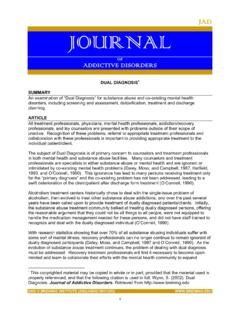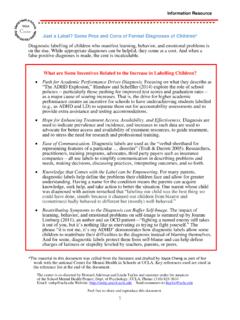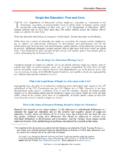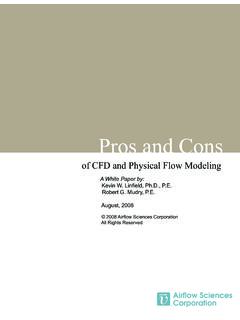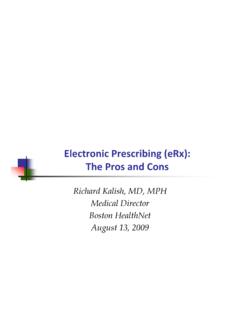Transcription of JAD06NN2 - Breining Institute
1 JAD/2006. JOURNAL OF. ADDICTIVE DISORDERS. Analyzing the Pros and cons of Multiple Relationships Between Chemical Addiction Therapists and their Clients. 1. ARTICLE. Abstract The wording of the 1992 Ethics Code implied that multiple relationships were inherently unethical, which essentially placed the burden of proof on the therapist (APA, 1992). In contrast, the wording of the 2002 Ethics Code Standard (Multiple Relationships) simply begins with a neutral definition of a multiple relationship; the 2002 code does not contain the implication that dual relationships are inherently unethical. Instead, the code clarifies that multiple relationships that are not exploitive or harmful or cause impairment are not unethical (Fisher, 2003). However, any boundary crossing has the potential to lead to a boundary violation and must therefore be examined very closely.
2 In those dual relationships in which harm eventually results to a client, the burden of proof will always fall on the therapist (Beauchamp & Childress, 2001). Introduction The New Ethics Code, Standard , explicitly states that multiple relationships that reasonably would not be expected to cause impairment or risk exploitation or harm are not inherently unethical (APA, 2002). The standard attempts to adopt a fair balance between the interests of the public and the interests of Chemical Addiction Therapists. On one hand, the Code was not designed to punish therapists who engage in benign multiple relationships. On the other hand, it does want authority to punish those who create unethical dependency or who engage in blatantly exploitative relationships (Fisher, 2003). According to this standard, it could even be ethical to enter into a treatment relationship with a person with whom the therapist has a current business or social relationship, as long as the relationship is not exploitative or clinically contradicted, although from a risk-management perspective I would strongly discourage that.
3 Thus, maintaining healthy boundaries in relationships with clients does not inherently require detached objectivity but does require professional judgment and a commitment to the best interest of the client (Taylor & Gazda, 1991). As such, the intersections of trust, boundaries, and appropriateness for both relationships are dependent on the therapist's knowledge that multiple relationships are going to occur; and just as importantly on the therapist's ability to effectively and ethically manage these relationships competently (Beauchamp & Childress, 2001). 1. This copyrighted material may be copied in whole or in part, provided that the material used is properly referenced, and that the following citation is used in full: Nardone, (2006). Analyzing the Pros and cons of Multiple Relationships Between Chemical Addiction Therapists and their Clients.
4 Journal of Addictive Disorders. Retrieved from 2007 Breining Institute (2006 JAD0702010640) 1. JAD/2006. JOURNAL OF ADDICTIVE DISORDERS. Discussion Definition According to its preamble, the new APA Ethics Code has as its goals the welfare and protection of the individuals and groups with whom therapists work and the education of members, students and the public regarding ethical standards of therapy (APA, 2002). Standard , on multiple relationships, is an excellent example of how the code achieves these goals (APA, 2002). The first paragraph of the standard offers a definition that is new to the code. The definition states that a multiple relationship arises when a therapist is in a professional role with an individual, and that, in addition to this professional role one of three other conditions is met.
5 A multiple relationship occurs when a therapist is in a professional role with a person and (1) at the same time is in another role with the same person, (2) at the same time is in a relationship with a person closely associated with or related to the person with whom the therapist has the professional relationship, or (3) promises to enter into another relationship in the future with the person or a person closely associated with or related to the person (APA, 2002). The first paragraph of Standard thus clearly informs therapists and the public what constitutes a multiple relationship (Fisher, 2003). The Test One of the most frequent misconceptions surrounding Standard is that multiple relationships are, by definition, unethical (Taylor & Gazda, 1991). The second paragraph of Standard makes it clear that simply meeting the definition does not speak to the ethics of multiple relationships (APA, 2002).
6 In order to assess the ethical appropriateness of the relationship, the second paragraph sets forth the following test: A therapist refrains from entering into a multiple relationship if the multiple relationship could reasonably be expected to impair the therapist's objectivity, competence, or effectiveness in performing his or her functions as a therapist, or otherwise risks exploitation or harm to the person with whom the professional relationship exists (APA, 2002). Several things should be pointed out about this test. First, the test sets out criteria: impairment in objectivity; competence or effectiveness; and a risk of exploitation or harm (Fisher, 2003). In assessing whether the test is met, the therapist will therefore consider the likelihood of impairment or the risk of exploitation or harm (Fisher, 2003).
7 Second, the phrase "reasonably expected" is central in determining what level of likelihood must be present, what a reasonable psychologist would expect to occur (Fisher, 2003). Would a reasonable psychologist expect that multiple relationships would cause impairment or risk of exploitation or harm (Fisher, 2003)? If a reasonable psychologist would not, the test is not met (Fisher, 2003). Third, there must be a causal connection between multiple relationships and the impairment or risk. In other words, something about the relationship must reasonably lead a therapist to expect that the relationship will cause impairment or risks exploitation and/or harm (Fisher, 2003). Thus, that a multiple relationship exists, in and of itself, does not meet the test, a reasonable therapist must expect that the multiple relationship will lead somewhere problematic (Fisher, 2003).
8 The third paragraph in Standard emphasizes this point: Multiple relationships that would not reasonably be expected to cause impairment or risk exploitation or harm are not unethical (APA, 2002). The definition in Standard educates therapists and the public about when a multiple relationship is present. The test that follows protects those with whom psychologists work, and 2007 Breining Institute (2006 JAD0702010640) 2. JAD/2006. JOURNAL OF ADDICTIVE DISORDERS. thereby promotes their welfare, by making a safe space available for the therapist and client to proceed (Fisher, 2003). Multiple relationships How does a therapist know whether a multiple relationship will lead to impairment, or if the relationship risks exploitation or harm? My feeling is that if a multiple relationship is likely to lead to impairment or risks, the relationship should be avoided.
9 Thus, the reasoning is not about values, protecting from harm and promoting welfare, but is rather about what effect a particular multiple relationship will have on a particular client (Beauchamp & Childress, 2001). While the answer to this clinical question has profound ethical implications, the disagreement remains on clinical and technical grounds. As therapists, we can agree upon and share the underlying values (Beauchamp & Childress, 2001). The APA Ethics Code recognizes that because of the many roles therapists assume in their work, family, community and social lives, multiple relationships arise in unexpected ways. Some of these multiple relationships are potentially harmful. The fourth paragraph in Standard addresses potentially harmful, unanticipated multiple relationships. If a therapist finds that, due to unforeseen factors, a potentially harmful multiple relationship has arisen, the therapist takes reasonable steps to resolve it with due regard for the best interests of the affected person and maximal compliance with the Ethics Code (APA, 2002).
10 The question is again what a reasonable therapist would do. The therapist's focus will be on the affected person's best interests and on complying with the Ethics Code, which has as its focus the individual's welfare and protection (Taylor & Gazda, 1991). Thus, the Ethics Code continues to return to and emphasize its central values of doing good and not doing harm, found in Principle A of the code's General Principles (Taylor & Gazda, 1991). Multicultural competence Multicultural competence is facilitated in this code by recognizing that in particular cultural contexts, closer and more complex involvement in the lives of clients may facilitate appropriate service and protection for the client (Fisher, 2003). This may be accomplished by the therapist's increased knowledge of the cultures involved in his/her clientele.
